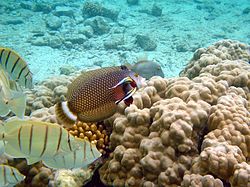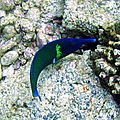- Wrasse
-
For other uses, see Wrasse (disambiguation).
Wrasses 
Moon wrasse, Thalassoma lunare, a typical wrasse Scientific classification Kingdom: Animalia Phylum: Chordata Class: Actinopterygii Order: Perciformes Suborder: Labroidei Family: Labridae
Cuvier, 1816Genera See text.
The wrasses are a family, Labridae, of marine fish, many of which are brightly colored. The family is large and diverse, with over 600 species in 82 genera, which are divided into nine subgroups or tribes.[1] They are typically small fish, most of them less than 20 centimetres (7.9 in) long, although the largest, the Humphead wrasse, can measure up to 2.5 metres (8.2 ft). They are efficient carnivores, feeding on a wide range of small invertebrates. Many smaller wrasses follow the feeding trails of larger fish, picking up invertebrates disturbed by their passing.[2]
The word "wrasse" comes via Cornish from the Welsh word gwrach meaning an old woman or hag.[3]
Contents
Distribution
Wrasses inhabit the Atlantic, Indian, and Pacific Oceans, usually in shallow water habitats such as coral reefs and rocky shores where they live close to the substrate.
Anatomy
 Lips of Labrus festivus
Lips of Labrus festivus
Wrasses have protractile mouths, usually with separate jaw teeth that jut outwards.[4] Many species can be readily recognized by their thick lips, the inside of which is sometimes curiously folded, a peculiarity which gave rise the German name of "lip-fishes" (Lippfische.)[5] The dorsal fin has 8–21 spines and 6–21 soft rays, usually running most of the length of the back. Wrasse are sexually dimorphic. Many species are capable of changing sex. Juveniles are a mix of males and females (known as Initial Phase or IP individuals) but the largest adults become territory-holding (Terminal Phase or TP) males.[4]
The wrasses have become a primary study species in fish-feeding biomechanics due to their jaw structure. The nasal and mandibular bones are connected at their posterior ends to the rigid neurocranium, and the superior and inferior articulations of the maxilla are joined to the anterior tips of these two bones, respectively, creating a loop of 4 rigid bones connected by moving joints. This "four-bar linkage" has the property of allowing numerous arrangements to achieve a given mechanical result (fast jaw protrusion or a forceful bite), thus decoupling morphology from function. The actual morphology of wrasses reflects this, with many lineages displaying different jaw morphology that results in the same functional output in a similar or identical ecological niche.[4]
Reproductive Behavior
Most labroids are protogynous hermaphrodites within a haremic mating system.[6] [7] Hermaphroditism allows for complex mating systems. Labroids exhibit three different mating systems: polygynous, lek-like, and promiscuous mating systems.[8] Group spawning and pair spawning occur within mating systems. The type of spawning that occurs depends on male body size.[7] Labroids typically exhibit broadcast spawning, releasing high amounts of planktonic eggs, which are broadcast by tidal currents; adult labroids have no interaction with offspring.[9] Wrasse of a particular subgroup of the Labridae family Labrini do not exhibit broadcast spawning.
Broodcare Behavior of Labrine Tribe
The subgroup Labrini arose from a basal split within family Labridae during the Eocene period.[1] Subgroup Labrini is composed of eight genera, wherein 15 out of 23 species exhibit broodcare behavior.[9] Broodcare behavior ranges from simple to complex parental care of spawn; males build algae nests or crude cavities, ventilate eggs, and defend nests against conspecific males and predators.[9] In species that express this behavior, eggs cannot survive without parental care.[10] Species of Symphodus, Centrolabrus, and Labrus genera exhibit broodcare behavior.
Cleaner wrasse
See also: Bluestreak cleaner wrasseCleaner wrasses working on dragon wrasse Novaculichthys taeniourus, Labroides sp. on a reef in Hawaii
Some wrasses are the known as Cleaner wrasse, the best-known of the cleaner fish. They are symbiotic, or more specifically, mutualistic fish, performing grooming functions for other species of fish, and benefiting themselves by feeding on what they remove. In this behaviour they are reminiscent of the Egyptian plover, which is said to remove parasites from crocodiles.
The "client" fishes will congregate at wrasse cleaning stations and wait for wrasses to swim into their open mouths and gill cavities to remove gnathiid parasites.
Cleaner wrasses are best known for feeding on dead tissue and scales and ectoparasites, although they are also known to 'cheat', consuming healthy tissue and mucus, which is energetically costly for the client fish to produce. The bluestreak cleaner wrasse, Labroides dimidiatus is one of the commonest cleaners found on tropical reefs. Few cleaner wrasses have been observed being eaten by predators, possibly because parasite removal is more important for predator survival than the short-term gain of eating the cleaner.[11]
Other wrasse species, rather than inhabiting fixed locations, make "house calls" — that is, their "clientele" are too territorial or shy to go to a cleaning station.
Significance to humans
Humans eat wrasse in many places. In the western Atlantic, the most common food species is the tautog.[5][dubious ]
Wrasse are common in both public and home aquaria. Some species are small enough to be considered reef safe.
Wrasse may be employed as cleaner fish to combat sea-lice infestation in salmon farms.[12]
Gallery
-
Gomphosus varius in Kona
-
Yellowtail coris wrasse, Coris gaimardi is being cleaned by Labroides phthirophagus. The picture was taken in Hawaii
-
Bluehead wrasse, Belize Barrier Reef
-
Clown wrasse, Coris aygula, Red Sea
-
Yellowtail wrasse, Coris gaimard, Hawaii
-
Pearl wrasse, Anampses cuvieri, Hawaii
-
Gomphosus caeruleus swimming with Yellow goatfish
Subgroups/Tribes
Hypsigenyines
Labrines
Cheilines
Scarines
Pseudocheilines
Novaculines
Pseudolabrines
Labrichthyines
JulidinesGenera
Acantholabrus
Achoerodus
Ammolabrus
Anampses
Anchichoerops
Austrolabrus
Bodianus
Centrolabrus
Cheilinus
Cheilio
Choerodon
Cirrhilabrus
Clepticus
Conniella
Coris
Ctenolabrus
Cymolutes
DecodonDiproctacanthus
Doratonotus
Dotalabrus
Epibulus
Eupetrichthys
Frontilabrus
Gomphosus
Halichoeres
Hemigymnus
Hologymnosus
Iniistius
Julichthys
Labrichthys
Labroides
Labropsis
Labrus
Lachnolaimus
LappanellaLarabicus
Leptojulis
Macropharyngodon
Malapterus
Minilabrus
Nelabrichthys
Notolabrus
Novaculichthys
Novaculoides
Ophthalmolepis
Oxycheilinus
Oxyjulis
Paracheilinus
Parajulis
Pictilabrus
Polylepion
Pseudocheilinops
PseudocheilinusPseudocoris
Pseudodax
Pseudojuloides
Pseudolabrus
Pteragogus
Semicossyphus
Stethojulis
Suezichthys
Symphodus
Tautoga
Tautogolabrus
Terelabrus
Thalassoma
Wetmorella
Xenojulis
Xiphocheilus
XyrichtysTimeline

References
- ^ a b Cowman, P.F.; D.R. Bellwood and L. van Herwerden. "Dating the evolutionary origins of wrasse lineages (Labridae) and the rise of trophic novelty on coral reefs". Molecular Phylogenetics and Evolution 52: 621–631. doi:10.1016/j.ympev.2009.05.015. PMID 19464378.
- ^ Choat, J.H. & Bellwood, D.R. (1998). Paxton, J.R. & Eschmeyer, W.N.. ed. Encyclopedia of Fishes. San Diego: Academic Press. pp. 211. ISBN 0-12-547665-5.
- ^ [1]
- ^ a b c Wainwright et al. (2005). "Many-to-One Mapping of Form to Function: A General Principle in Organismal Design?". Integrative & comparative biology 45: 256–262.
- ^ a b
 Chisholm, Hugh, ed (1911). "wrasse". Encyclopædia Britannica (11th ed.). Cambridge University Press.
Chisholm, Hugh, ed (1911). "wrasse". Encyclopædia Britannica (11th ed.). Cambridge University Press. - ^ Robertson, D.R.; R.R. Warner. "Sexual patterns in the labroid fishes of the Western Caribbean II: the parrotfishes (Scaridae)". Smithsonian Contributions to Zoology 255: 1–26.
- ^ a b Kazancioglu, E.; S.H. Alonzo. "A comparative analysis of sex change in Labridae supports the size advantage hypothesis". Evolution 64: 2254–2264.
- ^ Colin, P.L.; L. J. Bell. "Aspects of the spawning of labrid and scarid fishes (Pisces, Labroidei) at Enewetak Atoll, Marshall Islands with notes on other families (corrected reprint.)". Environmental Biology of Fishes 33: 330–345.
- ^ a b c Hanel, R.; M. W. Westneat and C. Sturmbauer. "Phylogenetic relationships, evolution of broodcare behavior, and geographic speciation in the Wrasse tribe Labrini.". Journal of Molecular Evolution 55: 776–789.
- ^ Taborsky, M.; B. Hudde and P. Wirtz. "Reproductive-behavior and ecology of Symphodus (Crenilabrus) ocellatus, a European wrasse with 4 types of male-behavior.". Behaviour 102: 82–118.
- ^ Trivers, R. L. 1971
- ^ "Sea Lice". Scottish Salmon Producers' Organisation. http://www.scottishsalmon.co.uk/science/sea_lice%284%29.aspx. Retrieved 8 June 2011.
- Sepkoski, Jack (2002). "A compendium of fossil marine animal genera". Bulletins of American Paleontology 364: p.560. http://strata.ummp.lsa.umich.edu/jack/showgenera.php?taxon=611&rank=class. Retrieved 2011-05-18.
External links
Categories:- Labridae
- Labroidei
-
Wikimedia Foundation. 2010.













